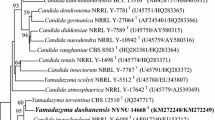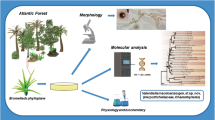Abstract
Four ascosporulating strains of an undescribed methanol-assimilating yeast species were isolated from forest habitats in Hungary. Three were recovered from rotten wood and one from leaves of a sessile oak (Quercus petraea). An additional isolate of the undescribed species sharing similar phenotypic characters with the above-noted strains was recovered from the gut of an unidentified beetle collected from under the bark of a coniferous tree in Bulgaria. A closely related, but somewhat divergent strain was recovered from insect frass in a Ponderosa pine (Pinus ponderosa) collected in New Mexico, USA. Analysis of the D1/D2 sequences of the LSU rRNA gene placed the new species in the Ogataea clade. The ITS and the D1/D2 LSU sequences of the rRNA gene repeats were compared for the above-noted strains and that of the type strain of Ogataea zsoltii, the closest neighbour among currently recognized Ogataea species. Their relatedness was investigated by parsimony network analysis as well. As a result of the sequence analysis, it was concluded that the six strains isolated from tree associated habitats represent a single new yeast species. Ogataea saltuana sp. nov. is proposed to accommodate these strains. The type strain NCAIM Y.01833T (CBS 10795T, NRRL Y-48448T) was recovered from rotten wood of Scotch pine (Pinus silvestris) in Hungary. The GenBank accession number for the D1/D2 domain nuclear large subunit rRNA gene sequence of strain NCAIM Y.01833T (CBS 10795T, NRRL Y-48448T) is EU327033. The MycoBank number of the new species is MB 519966.



Similar content being viewed by others
References
Clement M, Posada D, Crandall K (2000) TCS: a computer program to estimate gene genealogies. Mol Ecol 9:1657–1660
De Koning W, Harder W (1992) Methanol-utilizing yeasts. In: Murell JC, Dalton H (eds) Methane and methanol utilizers. Plenum Press, New York, pp 207–244
Dlauchy D, Tornai-Lehoczki J, Fülöp L, Péter G (2003) Pichia (Komagataella) pseudopastoris sp. nov., a new yeast species from Hungary. Antonie van Leeuwenhoek 83:327–332
Dlauchy D, Tornai-Lehoczki J, Sedláček I, Audy M, Péter G (2011) Debaryomyces psychrosporus sp. nov., a yeast species from a Venezuelan cave. Antonie van Leeuwenhoek 99:619–628
Fall R, Benson AA (1996) Leaf methanol—the simplest natural product from plants. Trends Plant Sci 1:296–301
Felsenstein J (1985) Confidence limits on phylogenies: an approach using the bootstrap. Evolution 39:783–791
Glushakova AM, Maximova IA, Kachalkin AV, Yurkov AM (2010) Ogataea cecidiorum sp. nov., a methanol-assimilating yeast isolated from galls on willow leaves. Antonie van Leeuwenhoek 98:93–101
Hart MW, Sunday J (2007) Things fall apart: biological species form unconnected parsimony networks. Biol Lett 3:509–512
Ji Z-H, Bai F-Y (2008) Ogataea ganodermae sp. nov., a methanol-assimilating yeast species isolated from basidiocarps of Ganoderma sp. Int J Syst Evol Microbiol 58:1502–1506
Kimura M (1980) A simple method for estimating evolutionary rates of base substitutions through comparative studies of nucleotide sequences. J Mol Evol 16:111–120
Kurtzman CP, Robnett CJ (1998) Identification and phylogeny of ascomycetous yeasts from analysis of nuclear large subunit (26S) ribosomal DNA partial sequences. Antonie van Leeuwenhoek 73:331–371
Kurtzman CP, Robnett CJ (2010) Systematics of methanol assimilating yeasts and neighboring taxa from multigene sequence analysis and the proposal of Peterozyma gen. nov., a new member of the Saccharomycetales. FEMS Yeast Res 10:353–361
Kurtzman CP, Suzuki M (2010) Phylogenetic analysis of ascomycete yeasts that form coenzyme Q-9 and the proposal of the new genera Babjeviella, Meyerozyma, Millerozyma, Priceomyces, and Scheffersomyces. Mycoscience 51:2–14
Lachance MA, Dobson J, Wijayanayaka DN, Smith AM (2010) The use of parsimony network analysis for the formal delineation of phylogenetic species of yeasts: Candida apicola, Candida azyma, and Candida parazyma sp. nov., cosmopolitan yeasts associated with floricolous insects. Antonie van Leeuwenhoek 97:155–170
Lachance MA, Wijayanayaka TM, Bundus JD, Wijayanayaka DN (2011) Ribosomal DNA sequence polymorphism and the delineation of two ascosporic yeast species: Metschnikowia agaves and Starmerella bombicola. FEMS Yeast Res 11:324–333
Lim YW, Kim J-J, Lu M, Breuil C (2005) Determining fungal diversity on Dendroctonus ponderosae and Ips pini affecting lodgepole pine using cultural and molecular methods. Fungal Divers 19:79–94
Limtong S, Srisuk N, Yongmanitchai W, Yurimoto H, Nakase T (2008) Ogataea chonburiensis sp. nov. and Ogataea nakhonphanomensis sp. nov., thermotolerant, methylotrophic yeast species isolated in Thailand, and transfer of Pichia siamensis and Pichia thermomethanolica to the genus Ogataea. Int J Syst Evol Microbiol 58:302–307
Martorell P, Fernández-Espinar MT, Querol A (2005) Sequence-based identification of species belonging to the genus Debaryomyces. FEMS Yeast Res 5:1157–1165
Nagatsuka Y, Saito S, Sugiyama J (2008) Ogataea neopini sp. nov. and O. corticis sp. nov., with the emendation of the ascomycete yeast genus Ogataea, and transfer of Pichia zsoltii, P. dorogensis, and P. trehaloabstinens to it. J Gen Appl Microbiol 54:353–365
Nakase T, Ninomiya S, Imanishi Y, Nakagiri A, Kawasaki H, Limtong S (2008) Ogataea paradorogensis sp. nov., a novel methylotrophic ascomycetous yeast species isolated from galleries of ambrosia beetles in Japan, with a close relation to Pichia dorogensis. J Gen Appl Microbiol 54:377–383
Nemecek-Marshall M, MacDonald RC, Franzen JJ, Wojciechowsky CL, Fall R (1995) Methanol emission from leaves. Plant Physiol 108:1359–1368
Péter G, Tornai-Lehoczki J, Fülöp L, Dlauchy D (2003) Six new methanol assimilating yeast species from wood material. Antonie van Leeuwenhoek 84:147–159
Péter G, Tornai-Lehoczki J, Dlauchy D (2007) Ogataea allantospora sp. nov., an ascomycetous yeast species from phylloplane. Antonie van Leeuwenhoek 92:443–448
Péter G, Tornai-Lehoczki J, Dlauchy D (2008) Ogataea nitratoaversa sp. nov., a methylotrophic yeast species from temperate forest habitats. Antonie van Leeuwenhoek 94:217–222
Péter G, Tornai-Lehoczki J, Dlauchy D (2009) Candida ogatae sp. nov., an anamorphic member of the Kuraishia clade. FEMS Yeast Res 9:328–333
Saitou N, Nei M (1987) The neighbor-joining method: a new method for reconstructing phylogenetic trees. Mol Biol Evol 4:406–425
Suh S-O, Blackwell M (2004) Three new beetle-associated yeast species in the Pichia guilliermondii clade. FEMS Yeast Res 5:87–95
Suh S-O, Zhou JJ (2010) Methylotrophic yeasts near Ogataea (Hansenula) polymorpha: a proposal of Ogataea angusta comb. nov. and Candida parapolymorpha sp. nov. FEMS Yeast Res 10:631–638
Tamura K, Peterson D, Peterson N, Stecher G, Nei M, Kumar S (2011) MEGA5: molecular evolutionary genetics analysis using maximum likelihood, evolutionary distance, and maximum parsimony methods. Mol Biol Evol (in press)
Wickerham LJ (1969) New homothallic taxa of Hansenula. Mycopathol Mycol Appl 37:15–32
Yamada Y, Maeda K, Mikata K (1994) The phylogenetic relationships of the hat-shaped ascospore-forming, nitrate-assimilating Pichia species, formerly classified in the genus Hansenula Sydow et Sydow, based on the partial sequences of 18S and 26S ribosomal RNAs (Saccharomycetaceae): the proposals of three new genera, Ogataea, Kuraishia, and Nakazawaea. Biosci Biotechnol Biochem 58:1245–1257
Yarrow D (1998) Methods for the isolation, maintenance and identification of yeasts. In: Kurtzman CP, Fell JW (eds) The yeasts: a taxonomic study, 4th edn. Elsevier Science Publications, Amsterdam, pp 77–100
Zhang Z, Schwartz S, Wagner L, Miller W (2000) A greedy algorithm for aligning DNA sequences. J Comput Biol 7:203–214
Acknowledgment
This work was partly supported by TAMOP 4.2.1/B-09/1/KMR-2010-0005 (D. Dlauchy).
Author information
Authors and Affiliations
Corresponding author
Rights and permissions
About this article
Cite this article
Péter, G., Dlauchy, D., Tornai-Lehoczki, J. et al. Ogataea saltuana sp. nov., a novel methanol-assimilating yeast species. Antonie van Leeuwenhoek 100, 375–383 (2011). https://doi.org/10.1007/s10482-011-9592-z
Received:
Accepted:
Published:
Issue Date:
DOI: https://doi.org/10.1007/s10482-011-9592-z




